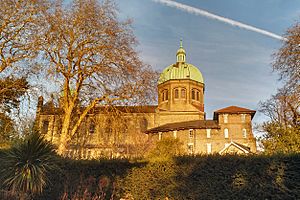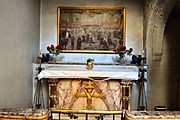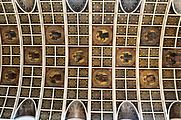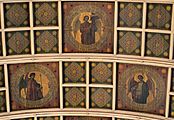St Joseph's Church, Highgate facts for kids
St Joseph's Church, Highgate is a beautiful Catholic church located on Highgate Hill in London. It's part of the Diocese of Westminster. This church was started by a special group called the Passionist Congregation in 1858. It's also a grade II listed building, which means it's an important historical and architectural site.
Contents
History of St Joseph's Church
How the Church Began
St Joseph's Church was first started in 1858 by Father Ignatius Spencer. He had joined the Passionist Order and found the perfect spot in Highgate. This first church was in an old building called the Old Black Dog Inn. It had a small chapel on the ground floor and rooms for the church community upstairs.
Building the New Church
The very first church building was put up between 1861 and 1863 by John Bird. But it soon became too small for everyone! So, work began on the much larger church you see today in 1888. The new church officially opened in 1889. This opening was a special event to celebrate the Jubilee of Pope Leo XIII. However, the church wasn't fully "consecrated" (made sacred) until 1932, after all the building costs were paid off.
Design and Features
The architect who designed St Joseph's Church was Albert Vicars. He mixed two old styles of building: Romanesque and Byzantine. The most striking part of the church is its large, green copper dome. This dome is so big and tall that you can see it from many different places across London! It's estimated to weigh a massive 2000 tons. Right next to the church is St Joseph’s Retreat, which is where the Passionist community lives.
Exploring the Church Interior
Inside St Joseph's Church, you'll find many interesting and beautiful features.
The Stations of the Cross
As you walk around, you'll see the Stations of the Cross. These are large, painted pictures that show different moments from the story of Jesus. They were created by F. Devriendt and put in place in 1886.
The Sanctuary Area
The sanctuary is the main area at the front of the church where the altar is. The high altar here has a special cover called a canopy, which is made from beautiful Sicilian marble. The area around the tabernacle (where the Eucharist is kept) is a copy of the original wooden design from 1861. Even the floor in the sanctuary is unique! It's a mosaic made from rocks found in the bed of the River Severn.
A second altar, made of marble and sandstone, was added in 1964. The paintings on the sanctuary walls were done by C. Langlin.
The Chapels Inside
St Joseph's Church has several smaller chapels, each with its own special details:
- Northeast Chapel: This chapel is dedicated to the saints of the Passionist order. It has a painting of St Paul of the Cross by M.A. Laby.
- Lady Chapel: Built in 1958, this chapel honors Mary, the mother of Jesus. Its altar is made of plain marble, and behind it, there are mosaics showing the Annunciation (when Mary was told she would have Jesus) and the Coronation of Mary. A white Carrara marble statue of the Virgin Mary from 1897 is also here. Next to this chapel, you'll find a wooden sculpture of St Dominic Barberi created in 1999.
- Sacred Heart Chapel: This chapel is located at the southeast side of the church.
- St Michael’s Chapel: This chapel has marble railings and a fancy altar. It's believed that these pieces were shown at a big exhibition in Paris in 1889! The chapel was built to remember Rev. Michael Watts Russell, who passed away in 1875. You can see a marble portrait of him here. The reliquary (a container for holy relics) in this chapel is said to have been designed by Cardinal Wiseman.
- Martyrs Chapel: This chapel features a marble altar and railings. It also has a large oil painting of the Forty Martyrs of England and Wales, who were people who died for their faith.
The Painted Ceiling
Look up, and you'll see the amazing painted ceiling! It was created by Nathaniel Westlake in 1891 and is considered some of his best work. There are 250 panels on the ceiling, and each one shows an angel holding a scroll with words from the "Te Deum," a very old Christian hymn.
The Church Organ
The church has a large organ with four keyboards, built by William Hill & Sons in 1898. It was installed after the Second World War as a way to remember the local people who lost their lives during the war.
Stained Glass Windows
On each side wall of the church, there are three beautiful stained glass windows high up, called clerestory windows. The windows on the south side show scenes of the Crucifixion, while those on the north side show the Holy Family. Between these windows, there are more paintings by Westlake that show the Mysteries of the Rosary.
Gallery










